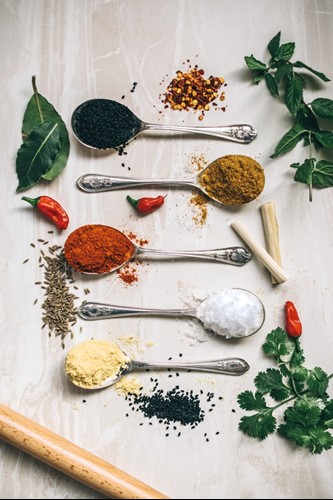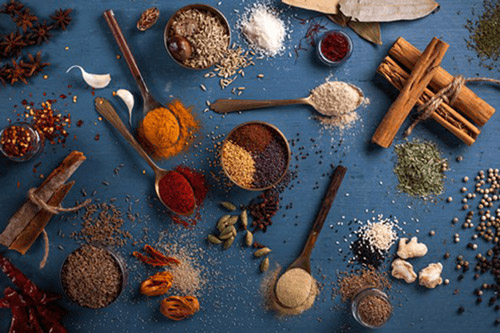According to the U.S. Food and Drug Administration (US FDA), the standard definition of spice is an, “Aromatic vegetable substances, in the whole, broken, or ground form, whose significant function in food is seasoning rather than nutrition”. American Spice Trade Association and US FDA has jointly prepared a list of spices. These spices are usually added during food preparation for enhancing flavor and color. The spices according to this list are:
- Allspice (Pimenta)
- Marjoram (Sweet Marjoram)
- Anise (Aniseed)
- Mustard Seed
- Basil
- Mustard Flour (“Mustard”)
- Bay Leaves
- Nutmeg
- Caraway Seed
- Oregano
- Cardamom (or Cardamon)
- Paprika
- Celery Seed
- Parsley Leaves
- Chervil
- Pepper, Black
- Cinnamon (Cassia)
- Pepper, Red
- Cloves
- Pepper, White
- Coriander Seed
- Rosemary
- Cumin Seed
- Saffron
- Dill Seed
- Sage
- Fennel Seed
- Savory
- Fenugreek
- Star Aniseed
- Ginger
- Tarragon
- Horseradish
- Thyme
- Mace
- Turmeric
Interestingly, traditional concepts of adding spices during preparation is not only to make the food delicious, but also to improve the shelf-life and maintain food quality during the preservation period. This is because spices also act as an antioxidant and have antimicrobial properties.
It has been found that when food production became industrialized, several synthetic antioxidants like butylated hydroxyanisole and butylated hydroxytoluene were introduced to prevent lipid oxidation. Lipid oxidation is one of the major cause of food spoilage. However, in recent days, people do not want to consume unnecessary synthetic products. They want more natural ingredients in every aspect of life, especially foods, to avoid chemical build-up in the body. Even since our ancestral time, spices are more vital to provide natural food preservation and are more than a means to make food tastier and eye-catching.
Read more: Nutrition Fact Label Changes
The phenolic compounds present in spices have an antioxidant effect by scavenging free radicals, chelating transition metals, quenching singlet oxygens, and enhancing the activities of antioxidant enzymes. Several experimental studies had evaluated the natural antioxidant properties existent in spices in comparison to synthetic antioxidants. These studies suggest that spices are good enough to fight against food spoilage due to their antioxidant properties.
Some of the phytochemicals present in commonly used spices have potent antimicrobial effects against different food-borne microorganisms. For example, cinnamic aldehyde and eugenol are two major phytochemicals present in cinnamon, which are effective against E. coli and Ps. fluorescens. Similarly, researchers have identified that the wide range of antimicrobial effects in different phytochemicals present in a variety of spices is significant against both gram-positive and gram-negative bacteria.

Several additional health benefits from adding spices during food preparation include:
- In Ayurveda, spices are used to maintain the body fluid (“humors”) balance.
- The aroma of the spices acts as an appetizer, as they can stimulate saliva secretion and promote the digestion process.
- Some spices such as ginger, cinnamon, and nutmeg are good for spleen health and help to relieve sore throats.
- Some spices, including garlic, have anti-H. pylori effects and leads to low rates of peptic ulceration. In addition, H. pylori-associated stomach cancer, liver disease, intestinal problems, and gallbladder related disorders are suppressed by certain herbs and spices due to their potent anti-microbial properties.
- The generation of free radicals is a regular metabolic process in healthy humans, but the accumulation of free radicals causes several chronic conditions. The antioxidant properties found in spices and herbs scavenges free radicals and assists to maintain balance between oxidants and antioxidants.
- USDA’s National Food and Nutrient Analysis Program (NFNAP) using the FRAP method lists the top 50 foods with antioxidants. Herbs and spices displayed the largest range in antioxidants. According to this study report, the top five antioxidants were ground cloves, dried oregano, ground ginger, cinnamon, and turmeric powder.
- Inflammation and immune system response are two associated conditions. Cyclooxygenase (COX) and lipoxygenase (LOX) are different immune system mediated pathways which generate different inflammatory mediators like prostaglandins, interleukins, and cytokines pathways. The release of these inflammatory mediators leads to inflammatory conditions such as tumors, cancer, and more. Curcumin present in turmeric inhibits COX and provides anti-inflammatory effects. Apart from turmeric, several other herbs and spices like basil, coriander, cumin, rosemary, thyme, and ginger also have potent anti-inflammatory effects.
- Researchers identified turmeric, pepper, garlic, rosemary, and cinnamon all possess anti-cancer properties. Saffron and its bioactive phytochemicals also have anti-tumor effects.
Read more: Nataly Alves from Silstar Foundation
How to use spices and how much
From the above discussion, it is evident that adding herbs and spices during food preparation has several benefits. That said, it is very important to know how to use these herbs and spices: the right herbs and spices in the right quantity is essential to achieve the mentioned benefits.
The Canadian Spice Association provides some tips and ideas about spice usage for food service providers. They note that while ingredients in a recipe become proportionally increased with serving size, this is not always true with spices.
- The quantity of spices like black pepper, cinnamon, ginger, cloves, chili powder and curry powder must be increased when increasing serving sizes. For example, if the recipe requires doubles in quantity, add all the spices double in amount. One should be cautious to be precise when measuring. All the ingredients in the recipe should be weighed properly before making the dish. Spices should not be added by measuring the volume, but it should always be according to the weight of the recipe content. However, this method is not applicable for Italian seasoning, mace, and nutmeg.
- In case of herbs and Italian seasoning, mace, and nutmeg, a specific formula is used. The herb should be increased to double for the first 100% increase in serving, but after that, put in only half of the original quantity of herbs for each multiplication of the original recipe. Example: for a 10 people recipe, 1tablespoon of basil can be increased to 100 portions. 2 tablespoons can result in 20 portions (double). Hence, 80 portions are remaining i.e. 8 X0.5 which come to 4 tablespoons of additional basil. Therefore, 6 i.e. 2+4 tablespoons of total basil will be required.
- Highly intense spices, such as hot red peppers, effects will increase exponentially when the amount is increased in a recipe. When increasing the serving size of a recipe containing red hot peppers, use caution. It can be doubled for the first doubling of the portion, but after that add only ¼ of the original amount for each multiple of the portion. For example, if a recipe requires 1 teaspoon of red pepper for a serving of 10, then 4 teaspoons will be required in a serving for 100.
MenuSano is a software tool which helps restaurants to be more transparent with their customers. MenuSano is widely used by restaurants and health conscious individuals. Try MenuSano for free and explore how you can offer better food choices for your customer.
Conclusion
“Health is wealth” and the nutritional value of food plays an important our in our well-being. MenuSano aims to educate our customers and audience about the importance of nutritious and healthy eating. Our nutrition analysis software is being used by many leading restaurants, hospitals, and health conscious individuals. It is economical and delivers exceptional value of your money. We are committed to your well-being and better health.



















